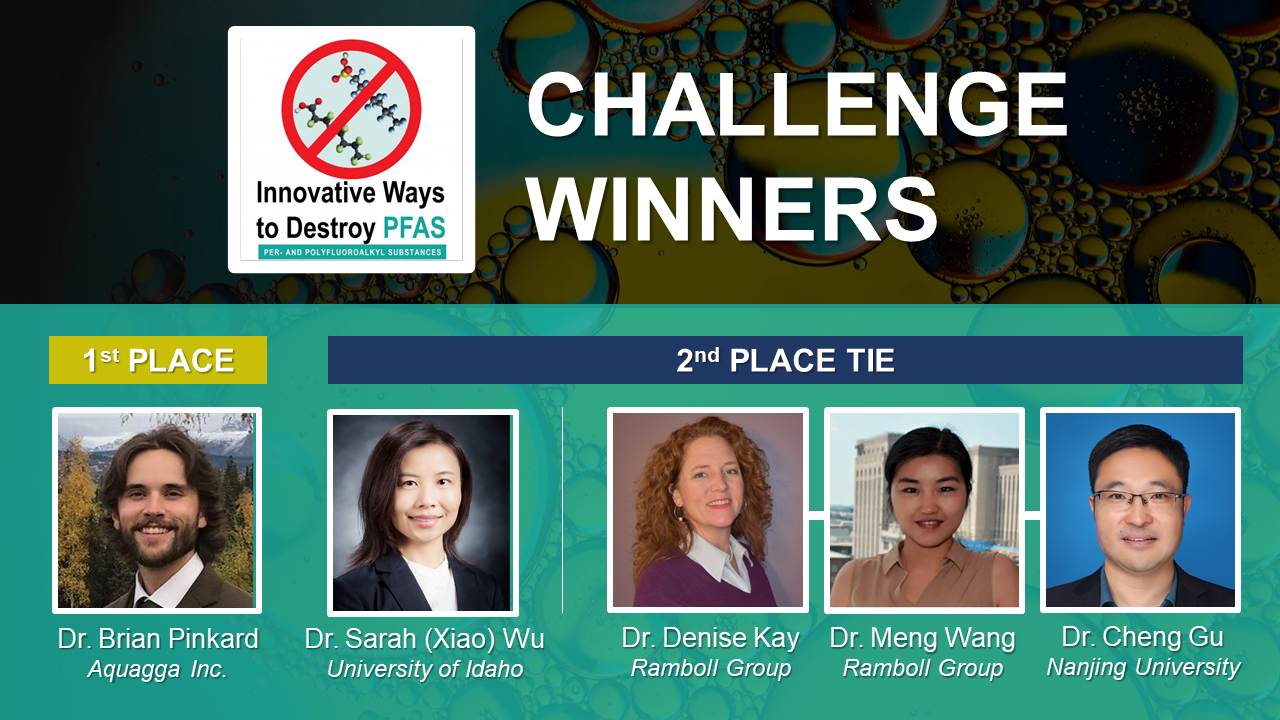Innovative Ways to Destroy PFAS Challenge
On this page:
Challenge
Background

Per- and polyfluoroalkyl substances (PFAS) are a group of synthetic chemicals that have been widely used for more than 60 years to make plastics, firefighting foams, and lubricants, and to help make products stain-resistant, waterproof, and nonstick. Newer forms of PFAS have been adopted over the past few years to replace older forms of PFAS compounds that were discontinued. Addressing and managing PFAS in the environment is one of the most pressing issues facing EPA, states and regions. This issue is particularly challenging because PFAS chemicals have a very strong carbon-fluorine chemical bond that leads to persistence in the environment and makes their complete destruction difficult. PFAS can be found at different concentrations in various waste streams including aqueous film forming foam (AFFF), bio-solids, ground water, sludge and soil.
The Challenge
The goal of the challenge is to discover new technologies and approaches that have the potential to remove at least 99 percent of PFAS in unused AFFF, without creating harmful byproducts. Although PFAS can be found in various waste streams, this challenge focused on unused AFFF because of its high concentration of PFAS and widespread use to fight fires.
Given the ubiquitous nature of PFAS, EPA and its state, tribal, local and federal partners are looking for greater certainty when making decisions about disposal and treatment of PFAS containing materials and PFAS contaminated media/waste.
EPA collaborated on the challenge with the U.S. Department of Defense’s Strategic Environmental Research and Development Program (SERDP) and Environmental Security Technology Certification Program (ESTCP); the Environmental Council of States (ECOS) and the Environmental Research Institute of the States (ERIS); Michigan Department of Environment, Great Lakes & Energy; and Colorado Department of Public Health & Environment.
Challenge winners will have the opportunity to submit their winning design concepts to DoD’s SERDP/ESTCP programs for further testing.
The challenge was intended to encourage the development of new approaches, technologies, or technology combinations.
The ideal technology sought by EPA and partners in this Challenge would:
- Perform onsite destruction of at least 99 percent of PFAS in AFFF formulations;
- Be currently on the market or near market;
- Destroy parent PFAS compounds;
- Destroy short-chain PFAS byproducts (e.g., CF4) if volatilization occurs;
- Destroy or neutralize any unwanted byproducts (e.g., HF) that would need to be incinerated or landfilled in a hazardous waste facility;
- Be more cost effective than thermal destruction;
- Have good environmental and public health outcomes (e.g., does not transfer PFAS or any unwanted byproducts into other media);
- Be potentially applicable to other PFAS waste streams (e.g., biosolids, contaminated ground water, etc).
Challenge Partners:
- U.S. Department of Defense’s Strategic Environmental Research and Development Program (SERDP) and Environmental Security Technology Certification Program (ESTCP)
- Environmental Council of States (ECOS)
- Environmental Research Institute of the States (ERIS)
- Michigan Department of Environment, Great Lakes and Energy (EGLE)
- Colorado Department of Public Health & Environment (CDPHE)
Winners

First Place Winner ($40,000 prize):
- Dr. Brian Pinkard, Chief Technology Officer and Co-Founder at Aquagga Inc., won first prize in our Innovative Ways to Destroy PFAS Challenge for a hydrothermal processing concept for the on-site disposal of PFAS-contaminated waste that may be potentially applicable for AFFF. Hydrothermal processing leverages the unique properties of high-temperature and high-pressure water to destroy PFAS compounds and minimize harmful byproducts.
Second Place Winners ($10,000 for each concept):
- Drs. Denise Kay and Meng Wang of the Ramboll Group in Denmark and Dr. Cheng Gu of Nanjing University in China won second place for their concept to use ultraviolet light and non-toxic additives to destroy PFAS. Drs. Kay and Wang are co-leaders of the PFAS Destroyer innovation project at the Ramboll Group, a global engineering, architecture and consultancy company headquartered in Denmark. Dr. Gu is a professor in the School of the Environment at Nanjing University in Nanjing, China.
- Dr. Sarah (Xiao) Wu, Assistant Professor of Engineering at the University of Idaho, tied for second place in our challenge for her concept using a continuous flow liquid-phase plasma discharge process to destroy PFAS in AFFF.
Prize
EPA is awarding $60,000 in prize money to the winning concepts. Challenge winners also will have the opportunity to submit their winning design concepts to DoD’s SERDP/ESTCP programs for further testing.
Eligibility
- Winning Solvers had to certify they did not have identical or essentially equivalent work currently funded by a Federal agency.
- Federal employees acting within the scope of their employment were encouraged to consult his or her ethics official before participating in the Challenge.
- Solvers were not required to give up any of their intellectual property (“IP”) rights to the Seeker to be eligible to receive an award.
- The Challenge was launched on August 25, 2020. Submissions to this Challenge had to be received by 11:59 PM (US Eastern Time) on November 23, 2020.
- Late submissions were not considered.
Judging Criteria:
All submissions were evaluated by EPA scientists and key representatives from the Department of Defense. ECOS/ERIS, Michigan EGLE and CDPHE also had the opportunity to provide state-level insight for finalists. Submissions were judged by how well they addressed the challenge requirements detailed in the “Challenge” section above.
